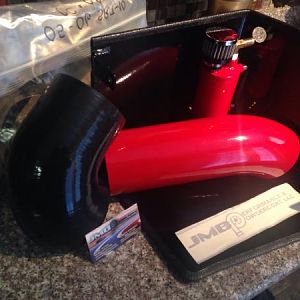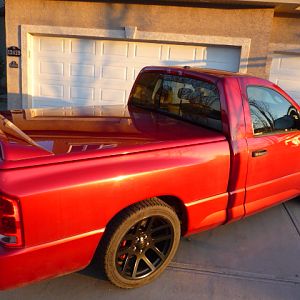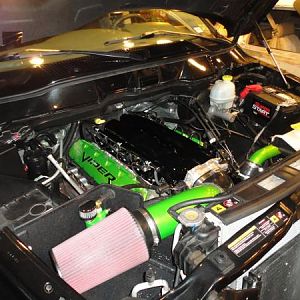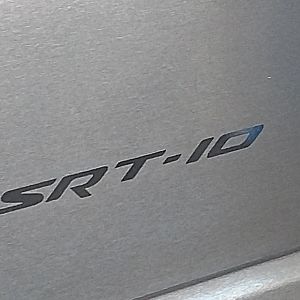Looking for a OEM hydraulic Fan Assembly. Hit me up if you have one or know of someone that has one.
You are using an out of date browser. It may not display this or other websites correctly.
You should upgrade or use an alternative browser.
You should upgrade or use an alternative browser.
OEM Hydraulic Fan Assembly
- Thread starter LitemUp
- Start date
- Joined
- Sep 16, 2021
- Messages
- 105
- Reaction score
- 140
Do you have a different one in your truck that you want to replace or do you need to just purchase one?
I found this a few years back, it may help.
As the info states: Watch those fan blades as they are sharp!!
**These are the same fan motors used on the Hemi-Trucks of the same year so there are a lot of them around. They are replaced as a completed assembly: Fan Motor, Fan Housing, Fan etc.
DIAGNOSIS: This diagnostic procedure should be used if the engine overheats or the A/C compressor cycles rapidly. 1. Non-hydraulic system - Check for low coolant, faulty thermostat, faulty temperature sensor, etc. - Is there a Non-hydraulic system problem? a. Yes >> Repair as necessary. b. No >> Go to Step #2.
2. Power steering fluid - Check the power steering fluid level in the reservoir - Is the fluid in the power steering pump reservoir below the dipstick “Add” mark? a. Yes >> Check for leaks and repair as required. Fill the reservoir to the proper level and proceed to Step #3. b. No >> Go to Step #3. CAUTION: Fan blade and/or shroud may have sharp edges!
3. Radiator cooling fan - Disconnect and isolate the negative battery cable from the battery. Rotate the fan counterclockwise (as viewed by the driver) using fingertips on the outer fan blade. Move the fan through 7 full rotations and notice the drag torque. - Does the fan spin freely through all 7 rotations with minimal finger exertion? a. Yes >> Go to Step #6. b. No >> Go to Step #4.
4. Does the torque needed to spin the fan significantly change as the fan is rotated? a. Yes >> Go to Step #18. b. No >> Go to Step #5
5. Is it difficult to turn the fan or does it require the effort of more than one finger? a. Yes >> Go to Step #18 b. No >> Go to Step #6
6. Testing the system - Connect the negative battery cable to the battery. Using the StarSCAN® perform the following tests with the engine running at idle speed. - Does the fan accelerate when given a 100% duty cycle command? a. Yes >> Go to Step #7. b. No >> Go to Step #12.
7. Does the fan decelerate when the duty cycle is changed from 100% to 0%? a. Yes >> Go to Step #8. b. No >> Go to Step #18.
8. At 0% duty cycle, turn the steering wheel to full left or right stop for up to 5 seconds (to stop fan rotation). - Does the fan rotate when the steering wheel is returned to center at 0% duty cycle? a. Yes >> Go to Step #9. b. No >> Go to Step #10.
9. Repeat Step #8, ten times. - Does the fan always resume rotation after the wheel is returned to center? a. Yes >> The hydraulic fan motor is OK. b. No >> Go to Step #10.
10. Turn the A/C system on. The ambient temperature or sun load must be high enough to cause the A/C compressor to cycle, this will normally be above 15.6° C / 60° F. With the A/C system operational, the fan speed should increase as the refrigerant pressure rises. If the A/C system does not operate because of low temperature (below 15.6° C / 60° F) or sun load, use the StarSCAN® to step the fan control motor solenoid duty cycle to 100%. - Does the fan always start soon after the A/C is turned “On” (or the duty cycle is set to 100%)? a. Yes >> Go to Step #11. b. No >> Go to Step #18.
11. Repeat Step #10, ten times stopping the fan between tests by turning the steering wheel. Does the fan speed always increase when A/C is turned “On” (100% duty cycle)? a. Yes >> The hydraulic motor is OK. b. No >> Go to Step #18.
12. Does pump noise increase indicating that the system pressure is increasing? a. Yes >> Go to Step #18. b. No >> Go to Step #13.
13. ELECTRICAL TESTING - Disconnect the 3 pin connector of the fan motor assembly jumper harness from the vehicle engine compartment wiring harness. Using the connector of the jumper harness for electrical measurements will normally allow easier access than if the connector at the hydraulic motor pressure control valve is used. Measure the resistance between terminal 1 and terminal 2 of the fan motor assembly jumper harness to determine fan motor solenoid resistance. (Fig. 3) - Is the resistance between 7 and 13 ohms? a. Yes >> Go to Step #14. b. No >> Go to Step #17.
14. Fabricate a 3 wire jumper harness between the vehicle engine compartment wiring harness and the fan motor assembly jumper harness connector. Insert an ammeter in the K173 BR/VT circuit (Fig. 3). Start the engine and set the duty cycle to 100%. - Is the current draw on circuit K173, BR/VT, between 0.5 and 1.5 amps? a. Yes >> Go to Step #17. b. No >> Go to Step #15.
15. Inspect for shorted or broken wires. - Were any wires shorted or broken? a. Yes >> Repair as necessary. b. No >> Go to Step #16.
16. Replace the Front Control Module (FCM).
17. Replace the fan control motor solenoid and retest the hydraulic fan motor.
18. Replace the hydraulic fan/motor/shroud assembly.
DIAGNOSTIC PROCEDURES:
Try the Fan-Spinning Test Above: Numbers 3, 4 & 5. This test seems conclusive and if mine passes, the most expensive replacement item is still functioning, and an electronic control has malfunctioned.
If that isn’t the case, then the power steering pump may be weak. I don’t think that is true as it isn’t noisy, and the steering is fine.
If the spin test fails, that leaves the purchase of a new Fan Module Assembly.
If the spin-test passes, make sure the electrical connector for the fan is hooked up and is in good (clean) condition. Then check the resistance of Pin 1 and Pin 2 of the connector as in Number 13 above. It may need to be replaced.
If the systems checked have passed thus far….
Disconnect the water temperature sensor during warm-up. At this time I can listen to the power steering pump as in #12 above.
As the info states: Watch those fan blades as they are sharp!!
**These are the same fan motors used on the Hemi-Trucks of the same year so there are a lot of them around. They are replaced as a completed assembly: Fan Motor, Fan Housing, Fan etc.
DIAGNOSIS: This diagnostic procedure should be used if the engine overheats or the A/C compressor cycles rapidly. 1. Non-hydraulic system - Check for low coolant, faulty thermostat, faulty temperature sensor, etc. - Is there a Non-hydraulic system problem? a. Yes >> Repair as necessary. b. No >> Go to Step #2.
2. Power steering fluid - Check the power steering fluid level in the reservoir - Is the fluid in the power steering pump reservoir below the dipstick “Add” mark? a. Yes >> Check for leaks and repair as required. Fill the reservoir to the proper level and proceed to Step #3. b. No >> Go to Step #3. CAUTION: Fan blade and/or shroud may have sharp edges!
3. Radiator cooling fan - Disconnect and isolate the negative battery cable from the battery. Rotate the fan counterclockwise (as viewed by the driver) using fingertips on the outer fan blade. Move the fan through 7 full rotations and notice the drag torque. - Does the fan spin freely through all 7 rotations with minimal finger exertion? a. Yes >> Go to Step #6. b. No >> Go to Step #4.
4. Does the torque needed to spin the fan significantly change as the fan is rotated? a. Yes >> Go to Step #18. b. No >> Go to Step #5
5. Is it difficult to turn the fan or does it require the effort of more than one finger? a. Yes >> Go to Step #18 b. No >> Go to Step #6
6. Testing the system - Connect the negative battery cable to the battery. Using the StarSCAN® perform the following tests with the engine running at idle speed. - Does the fan accelerate when given a 100% duty cycle command? a. Yes >> Go to Step #7. b. No >> Go to Step #12.
7. Does the fan decelerate when the duty cycle is changed from 100% to 0%? a. Yes >> Go to Step #8. b. No >> Go to Step #18.
8. At 0% duty cycle, turn the steering wheel to full left or right stop for up to 5 seconds (to stop fan rotation). - Does the fan rotate when the steering wheel is returned to center at 0% duty cycle? a. Yes >> Go to Step #9. b. No >> Go to Step #10.
9. Repeat Step #8, ten times. - Does the fan always resume rotation after the wheel is returned to center? a. Yes >> The hydraulic fan motor is OK. b. No >> Go to Step #10.
10. Turn the A/C system on. The ambient temperature or sun load must be high enough to cause the A/C compressor to cycle, this will normally be above 15.6° C / 60° F. With the A/C system operational, the fan speed should increase as the refrigerant pressure rises. If the A/C system does not operate because of low temperature (below 15.6° C / 60° F) or sun load, use the StarSCAN® to step the fan control motor solenoid duty cycle to 100%. - Does the fan always start soon after the A/C is turned “On” (or the duty cycle is set to 100%)? a. Yes >> Go to Step #11. b. No >> Go to Step #18.
11. Repeat Step #10, ten times stopping the fan between tests by turning the steering wheel. Does the fan speed always increase when A/C is turned “On” (100% duty cycle)? a. Yes >> The hydraulic motor is OK. b. No >> Go to Step #18.
12. Does pump noise increase indicating that the system pressure is increasing? a. Yes >> Go to Step #18. b. No >> Go to Step #13.
13. ELECTRICAL TESTING - Disconnect the 3 pin connector of the fan motor assembly jumper harness from the vehicle engine compartment wiring harness. Using the connector of the jumper harness for electrical measurements will normally allow easier access than if the connector at the hydraulic motor pressure control valve is used. Measure the resistance between terminal 1 and terminal 2 of the fan motor assembly jumper harness to determine fan motor solenoid resistance. (Fig. 3) - Is the resistance between 7 and 13 ohms? a. Yes >> Go to Step #14. b. No >> Go to Step #17.
14. Fabricate a 3 wire jumper harness between the vehicle engine compartment wiring harness and the fan motor assembly jumper harness connector. Insert an ammeter in the K173 BR/VT circuit (Fig. 3). Start the engine and set the duty cycle to 100%. - Is the current draw on circuit K173, BR/VT, between 0.5 and 1.5 amps? a. Yes >> Go to Step #17. b. No >> Go to Step #15.
15. Inspect for shorted or broken wires. - Were any wires shorted or broken? a. Yes >> Repair as necessary. b. No >> Go to Step #16.
16. Replace the Front Control Module (FCM).
17. Replace the fan control motor solenoid and retest the hydraulic fan motor.
18. Replace the hydraulic fan/motor/shroud assembly.
DIAGNOSTIC PROCEDURES:
Try the Fan-Spinning Test Above: Numbers 3, 4 & 5. This test seems conclusive and if mine passes, the most expensive replacement item is still functioning, and an electronic control has malfunctioned.
If that isn’t the case, then the power steering pump may be weak. I don’t think that is true as it isn’t noisy, and the steering is fine.
If the spin test fails, that leaves the purchase of a new Fan Module Assembly.
If the spin-test passes, make sure the electrical connector for the fan is hooked up and is in good (clean) condition. Then check the resistance of Pin 1 and Pin 2 of the connector as in Number 13 above. It may need to be replaced.
If the systems checked have passed thus far….
Disconnect the water temperature sensor during warm-up. At this time I can listen to the power steering pump as in #12 above.
Support Us
Become A Supporting Member Today!





